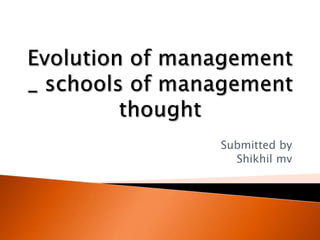
Evolution of management _ schools of management thought.pptx
- 2. Both theory and history are indispensable tools for managing contemporary organizations. A theory is a conceptual framework for organizing knowledge that provides a blueprint for various courses of action.
- 3. Name Period Contribution Robert Owen 1771-1858 Proposed legislative reforms to improve working conditions of labor Charles Babbage 1792-1871 Advocated the concept or ‘division of labor’ Andrew Ure 1778-1857 Advocated the study of management Charles Dupin 1784-1873 Henry R.Towne 1844-1924 Emphasized the need to consider management as separated field of study and the importance of business skills for running a business.
- 4. 1.The Classical theory of management a) Scientific Management b) Bureaucratic Management c) Administrative Management 2.The Behavioural Approach 3.The Quantitative Approach
- 5. Forms the foundation for the field of management The schools for management thoughts are: Scientific Management Administrative Theory Bureaucratic Management
- 6. 1) Scientific task setting based on time, motion and fatigue study 2) Fitting the “right person for the right job” by proper selection, training and placement of personnel. 3) Improvement in work by i. Standardisation of tools and equipment ii. Improvement In Work environment
- 7. Scientific task setting-fair day’s work Work study - method, time, fatigue and motion study Planning the task Standardization Scientific selection and training Differential piece-wage plan Specialzation
- 8. It promote individualism rather than team spirit Worker unfit for other types of jobs It ignores the averge worker Repettive and monotonous work
- 9. It focused on principles that could be used by managers to coordinate the internal activities of organizations. Henry Fayol (1841-1925) Fayol classified the business operations of an organization into six activities and then outlined 14 principles of management.
- 10. 1. Technical operations 2. Commercial operations 3. Financial operations 4. Security operations 5. Accounting operations 6. Managerial operations a. Planning b. Organizing c. Command d. Coordination e. control
- 11. 1.Division of work 2.Authority and responsibility 3.Discipline 4.Unity of command 5.Unity of direction 6. Subordination of the individual interest to the general interest 7. Remuneration 8. Centralization: 9. Scalar chain 10.Order 11.Equity 12.Stability of staff 13.Initiative 14.Espirit de corps (team spirit
- 12. According to Weber, a bureaucracy is highly structured, formalized, and impersonal organization. He has advocated the necessity of a formal organization structure with set rules and regulations. He identified a set of characteristics of large organizations which helped in their rational operation. Such organizations were known as bureaucratic organizations.
- 13. Max Weber (1864-1920) Work specification and division of labor Abstract rules and regulations Impersonal relations b/w people Hierarchy of organization structure Selection and promotion based upon technical competence and excellence
- 14. Consistent employee behaviour Overlapping and conflicting job duties are eliminated Optimum utilization of human resources Division of labour makes the workers specialists
- 15. Too much red tape and paperwork Employees do not care about the organization Employees treat like machines and not like individuals Resistance to change and introdution of new techniques of operations
- 16. Increase in production and managerial efficiency through an understaning of the people Application of behavioral science such as psychology, sociology & anthropology to the study of human relationship. Individuals may behave differently under different situations. Attempts should be made to connect organisational goals & human needs. Management must develop social skills in addition to technical skill. Man to man relationship, team spirit & group
- 17. This approach is attributable to Elton Mayo (1880-1949) and his Hawthorne experiments Main contributors Abraham Maslow –Hierarchy of Needs McGregor – Theory X & Theory Y
- 18. It includes the application of statistics, optimization models, information models and computer simulations. More specifically, this approach focuses on achieving organizational effectiveness. Management problems can be described In Mathematical models. Operation research , mathematical tools, simulation and model building are the basic methodologies developed by this approach.
- 19. It stresses the use of mathematical models and statistical methods for decision-making. Another name is the Operations Research. Applied in the areas like capital budgeting, production scheduling, product strategy management, human resource planning and inventory management.
- 20. It deals with the effective management of the production process and the timely delivery of an organization’s products and services.
- 21. Management information systems focuses on designing and implementing computer-based information systems for business organizations
